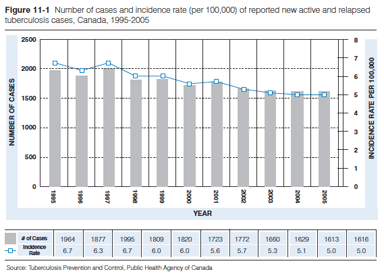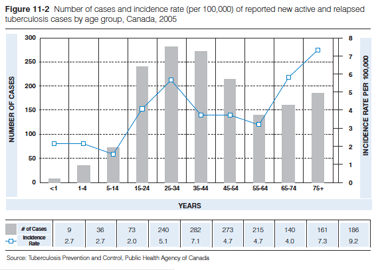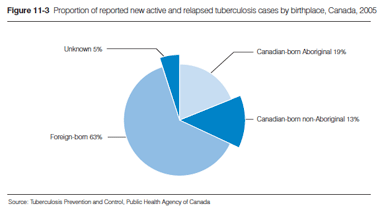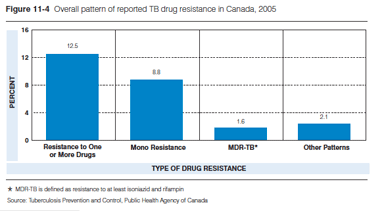Tuberculosis
Introduction
Tuberculosis (TB) continues to be a major health problem worldwide. The World Health Organization (WHO) declared tuberculosis a global emergency in 1993 and warned of a specific TB emergency in Africa in 2005. It is estimated that one-third of the world’s population is infected with Mycobacterium tuberculosis—the cause of TB. Approximately 9 million new cases of active TB disease develop each year, and almost 2 million persons die of the disease. Expressed otherwise, there is a new case in the world every 4 seconds and a death every 19 seconds. This makes tuberculosis a leading cause of morbidity and mortality—a fact with important implications for Canada due to international travel and immigration from high TB-incidence countries.
Severe epidemics of multidrug-resistant TB (MDR-TB)—the form resistant to at least isoniazid (INH) and rifampin—continue in several regions of the world. There are about half a million new and previously treated MDR-TB cases per year globally. Clusters of extensively drug-resistant TB (XDR-TB)—that is, MDR-TB with additional resistance to two or more kinds of second-line anti-TB drugs—have also been reported. These forms of TB are very difficult and costly to treat and represent a significant challenge to TB control worldwide.
After peaking in the early 1940s, the number of TB cases reported in Canada has shown large declines. From 1994 to 2005, the rate decreased by an average of 3.4% per year to 5.0 per 100,000 population. However, the decline in the rate slowed to only 2.2% annually between 2001 and 2005, and the rate remained constant in 2004 and 2005. In the spirit of the international STOP-TB Partnership’s Global Plan,1 the Canadian TB Committee established a goal to reduce Canada’s incidence rate to 3.6 per 100,000 or lower by 2015. This will require further substantial declines of approximately 3% annually.
Most people who are exposed to TB bacteria do not develop TB disease, as the immune system kills or effectively controls the bacteria. A condition in which the bacteria remain alive but inactive in the body is called latent TB infection. A person with latent TB infection has no symptoms, is not sick, and poses no current or immediate risk of spreading the bacteria. However, under certain circumstances, latent TB infection can progress to active (and potentially infectious) TB disease. It is estimated that up to 12% of Canadians have latent TB infection.2
Risk Factors for Latent TB Infection and TB Disease
Certain population groups in Canada have an increased risk of TB infection. These groups include:
- those who have come into close contact with individuals with known or suspected active TB,
- people born in or travelling to countries where TB is widespread,
- Aboriginal people who have lived in a community with a high rate of TB disease,
- homeless people,
- residents of some long-term care or correctional facilities, and
- persons who work with any of these groups, such as health care workers.
People with a weakened immune system run a greater risk that infection will develop into TB disease. Conditions that weaken the immune system include HIV infection, treatment with immunity-suppressing drugs, end-stage kidney disease, cancer of the head and neck, diabetes mellitus, silicosis, being underweight, and long-term cigarette smoking. Babies, pre-school children and the elderly are also at greater risk, because their immune systems are weaker than those of healthy adults.
Symptoms of TB Disease
The symptoms of TB disease in the lungs can include a bad cough lasting longer than three weeks, pain in the chest, coughing of blood or sputum, weakness or extreme fatigue, weight loss, lack of appetite, chills, fever and night sweats.
Incidence
Note: All data in this section are provisional until the release of
Tuberculosis in Canada 2005. For current TB statistics, please see www.publichealth.gc.ca/tuberculosis.
In 2005, 1,616 cases of new and relapsed active cases of tuberculosis were reported in Canada (5.0 per 100,000). Since 1995, the incidence of new active and relapsed tuberculosis cases reported in all of Canada has declined; however, this decline has slowed recently (Figure 11-1).
In 2005, the incidence rates were highest among the 65-74 and 75 and over age groups, but the greatest number of tuberculosis cases reported was among individuals aged 25 to 44 years (Figure 11-2).
In 2005, almost two-thirds (63.0%) of TB cases involved individuals who were born outside of Canada. Of the 1,016 cases who were foreign-born, 329 (32.4%) were from the Western Pacific WHO region (Figure 11-3).
Antibiotic sensitivity testing of 1,308 samples of Mycobacterium tuberculosis and M. tuberculosis complex bacteria in 2005 found 163 (12.5%) to be resistant to one or more first-line anti-TB drugs. Resistance to INH was the most common type of drug resistance reported (8.3%). Multidrug-resistant TB (MDR-TB), a pattern of resistance that greatly complicates treatment, accounted for 1.6% of the samples (Figure 11-4).
Costs
As with most diseases, the costs attributable to tuberculosis in Canada stem from multiple sources. Beside the evident costs of hospitalization, laboratory procedures and medication, there are also less obvious costs, including public health activities, such as contact tracing, maintaining surveillance systems, and supporting immigration-related policies and programs for health screening.
Data on the estimated costs of tuberculosis in Canada are limited. However, a recent report completed for the Public Health Agency of Canada estimated that total TB-related expenditures in Canada were $74 million in 2004, equivalent to $47,290 for every active TB case diagnosed in that year.3
Discussion and Implications
Canada is considered a low TB-incidence country; yet, because of a number of factors, the public health and economic impact of tuberculosis remains significant among certain high risk groups in Canada:
- First, at least 80% of immigrants to Canada in the past 10 years have come from high TB-incidence countries. While the pre-immigration medical examination process may find active TB disease and prevent immigration until treated, many Canadian immigrants have latent TB infection. TB bacteria are present in their body, but the individuals are not ill and not infectious. While most will never develop active TB disease, some do, often shortly after immigration but sometimes later in life. One study suggests that Canada’s contribution to TB control in the source countries of immigrants could reduce the number of future cases of actual TB disease in this country.4 Also, better tools are needed to diagnose latent TB infection in immigrants after they arrive in Canada. More effective ways to treat those at high risk for progression to active disease are also needed.
- Second, although the total number of TB cases is highest among the foreign-born, Aboriginal people in Canada have higher rates of TB (26.8 per 100,000) than the foreign-born (14.8 per 100,000) and the general population in Canada (5.0 per 100,000).
- Third, the effects of poverty, including crowded housing, are associated with increased TB incidence among some Aboriginal communities and among the urban homeless.
- Fourth, the global spread of the TB-HIV co-epidemic represents another concern. HIV-positive individuals are up to 100 times more likely than HIV-negative individuals to progress from latent TB infection to active TB disease.
- Finally, the prevalence of drug-resistant tuberculosis bacterial strains represents a threat throughout the world and has the potential to increase here in Canada. To address this concern, we need to continue to monitor drug resistance in cases and prevent drug resistance from developing by providing comprehensive TB treatment.
Efforts continue to target many of these risk factors and high-risk groups for the prevention and control of TB in Canada. These activities are co-ordinated and enhanced by the Canadian Tuberculosis Committee, whose members are drawn from all provinces and territories, federal departments involved with TB prevention and control, and various non-governmental health organizations. The sixth edition of Canadian Tuberculosis Standards, scheduled for release in 2007, was jointly produced by the Canadian Lung Association/Canadian Thoracic Society and Public Health Agency of Canada as the definitive prevention and control guidelines for Canada. Editions will become available on-line at www.publichealth.gc.ca/tuberculosis or in paper format from Lung Association offices.
The continuous monitoring of TB in Canada remains a critical component of an overall TB control strategy. To this end, the Public Health Agency of Canada and all provinces and territories continue to enhance national tuberculosis case and drug resistance surveillance by collecting more information on risk markers and risk factors for each TB case and by developing a pan-Canadian TB bacteria genotype (fingerprint) database.
1 Stop TB Partnership and World Health Organization. The global plan to stop TB 2006-2015. Geneva: World Health Organization; 2006.
2 Public Health Agency of Canada. Tuberculosis prevention and control. Unpublished data, 2007
3 Menzies D, Oxlade O, Lewis M. Costs For tuberculosis care In Canada. Ottawa: Public Health Agency of Canada; 2006. http://www.phac-aspc.gc.ca/tbpc-latb/costtb/index_e.html
4 Schwartzman K, Oxlade O, Barr RG, Grimard F, Acosta I, Baez J, Ferreira E, Melgen RE, Morose W, Salgado AC, Jacquet V, Maloney S, Laserson K, Mendez AP, Menzies D. Domestic returns from investment in the control of tuberculosis in other countries. N Engl J Med. 2005 Sep 8;353(10):1008-1020.




